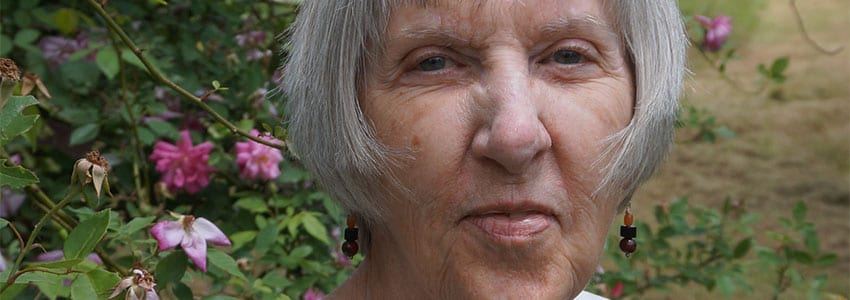“I wasn’t a typical grad student.” While Martha lived in Ann Arbor for only two years, she accomplished a significant amount in that short time frame. She recalls, “People were surprised I was in and out as quickly as I was. Most students in anthropology seemed to hang around forever, partly due to the nature of the research. My situation was certainly unique. It helped that I came with a master’s degree; that set me off from other grad students who were just starting. I had a number of publications already and had been doing research” on the archeology of Kentucky and the Ohio Valley.
Indeed, early in her second year, she was courted back to the University of Kentucky where she completed her Master’s degree to teach and run the museum while the director was on sabbatical. “It was a great opportunity, and my U-M professors told me to take my prelims first and get some idea of what they’re like before going. So my second year, I was a teaching fellow, was taking classes and studying for my prelims. That’s what I did with all my time. I got out less in town and on campus than I otherwise would have.” Two years of teaching at UK and working on her dissertation left her with a much wider range of experience than most grad students receive.
Martha was a focused student, partially because she was trying to pay for graduate school on her own. She recalls, “I knew what I wanted. By the time I got there I was in my late 20s. I could focus on it. My parents generously supported my undergraduate education and helped a little in grad school, but the teaching fellowship gave me in-state tuition rates, and that was a great help in being able to afford U-M. I worked with a field crew on an archaeological site excavation during summer of ‘64 to earn money, and that was a wonderful experience. At end of my second year, U-M received NSF funding to pay stipends to teaching fellows to attend classes in the summer. So my summer of ‘65 coursework and French exam were supported by that stipend. I was fortunate to cobble together money from various sources.”
Although Martha wasn’t at Michigan long, she established strong connections to the university. She explains, “One of the reasons I picked U-M was Dr. James B Griffin, the Director of the Museum of Anthropology and a highly respected authority on Eastern United States archeology. If you were interested in that region, Michigan was the best place. He ended up being my dissertation advisor. I never officially took his classes, but I sat in on them. It was so beneficial to be a student of his. There was a continuity of students with department faculty and social anthropology. It all worked together.”
With Ph.D. in hand, Martha was hired by the Arkansas Archeological Survey, a division of the University of Arkansas System, and remained there for 37 years. In 1976, Martha was offered a position to direct archeological research at a research station in Arkansas on a newly developing Native American site at what became Toltec Mounds State Park, and she spent almost thirty years doing just that. She recalls, “It was fantastic to take a 100 acre site and figure out what was there, develop public programs, and do research on all of it.”
Originally, 16 mounds existed, all built by the Native Americans with basketloads of soil that was collected in the area. They were built for different purposes and at different times 700 AD to 1050 AD. The mounds served as gathering places for celebrations and served as a major religious center for the community. There was much to celebrate in the region, as this was a thriving community supported by large farming community in the area. Martha elaborates, “People living in Mississippi Valley during this time period were adopting and developing farming techniques, and a lot of the crops they were growing at Toltec were plants we don’t normally think of as food crops but were domesticated native plants or regional plants like may grass and pig weed. Natives were also hunting extensively with an emphasis on deer and turkey and fish from the rivers. They subsisted on a diverse diet. At least one of the mounds probably was a burial ground. Some digging prior to the land purchase did uncover some burial sites. One of the mounds we spent a lot of time on was a low platform mound where we discovered massive amounts of food remains – probably was a mound that was involved in rituals and religious practices that included community feasts. The two big mounds are still mysterious in that sense, but they were probably platforms used in ceremonies.”
Her work was a combination of research, teaching and development of public programs. She explains, “One of the objectives was to investigate the site with as little disruption as possible. In archeology, we would destroy a mound if we really researched it, but if they were preserved, improvements in archeological techniques would mean we could learn more later. On the two big mounds, 40 and 50 feet high, we had done almost nothing to them. It would have been extremely expensive and we would only learn about that one mound, but I wanted to learn about the whole site. We excavated six mounds, all low mounds and all badly damaged by agriculture over the last century. The average visitor can’t even tell they are there. That’s where I concentrated the initial research. My major interest when I retired was completing a report on all 28 years doing Toltec research.”
A cancer survivor, Martha lives near her family in Texas and published a report on her research in 2012. She sums up her meaningful career, saying, “It’s been a long and interesting career and I enjoyed working outdoors. I’ve met lots of people because of their interest in archeology.”

